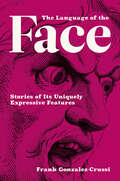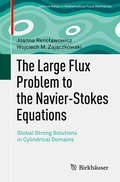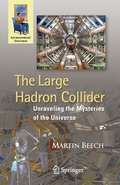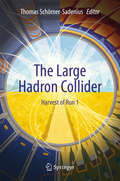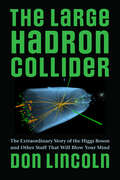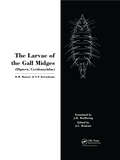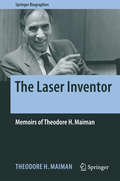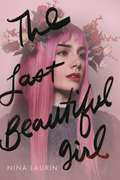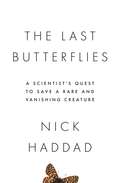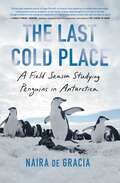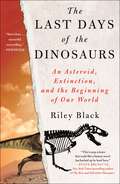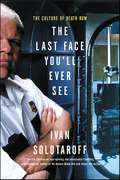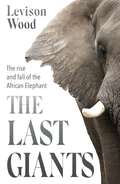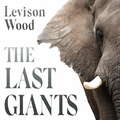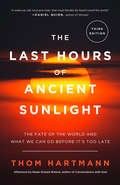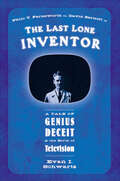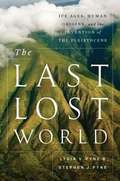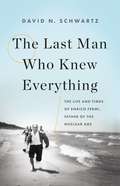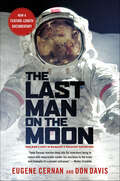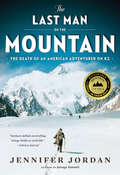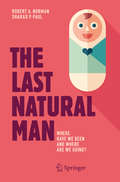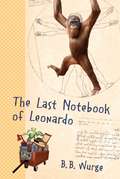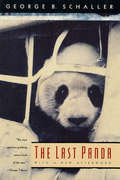- Table View
- List View
The Language of the Face: Stories of Its Uniquely Expressive Features
by Frank Gonzalez-CrussiA broad and riveting cultural history of physiognomy, exploring how the desire to divine deeper meaning from our looks has compelled humans for millennia.How do you read a face? For thousands of years, artists, philosophers, and scientists have explored the question of what our outer appearance might reveal about our inner selves. In The Language of the Face, a marvelously comprehensive exploration of the pseudoscience of physiognomy, Frank Gonzalez-Crussi considers over a millennium&’s worth of primary sources to paint a splendid portrait of the face&’s cultural symbology. Gonzalez-Crussi, an acclaimed pathologist and writer, transcends disciplines with a singular balance of depth and levity. Blending literary analysis of both ancient and modern texts with the insights of medical anthropology, his narrative ranges from an investigation into &“nasal semiotics&”—a subject whose legacy persists most destructively in myths of racial typology—to equally astute analyses of the thrills of the erotic kiss, the diagnostic art of astrology, and the enlightening qualities of supposed ugliness. While our appearances may ultimately be no more than surface-level signifiers of identity, Gonzalez-Crussi&’s work is anything but superficial in its treatment of the consummately human urge to find profound meaning amidst seemingly arbitrary attributes. As rigorously researched as it is wildly entertaining, The Language of the Face is a vibrant contribution to both the emerging field of medical humanities and the popular understanding of aesthetics and physiology at large.
The Large Flux Problem to the Navier-Stokes Equations: Global Strong Solutions in Cylindrical Domains (Advances in Mathematical Fluid Mechanics)
by Joanna Rencławowicz Wojciech M. ZajączkowskiThis monograph considers the motion of incompressible fluids described by the Navier-Stokes equations with large inflow and outflow, and proves the existence of global regular solutions without any restrictions on the magnitude of the initial velocity, the external force, or the flux. To accomplish this, some assumptions are necessary: The flux is close to homogeneous, and the initial velocity and the external force do not change too much along the axis of the cylinder. This is achieved by utilizing a sophisticated method of deriving energy type estimates for weak solutions and global estimates for regular solutions—an approach that is wholly unique within the existing literature on the Navier-Stokes equations. To demonstrate these results, three main steps are followed: first, the existence of weak solutions is shown; next, the conditions guaranteeing the regularity of weak solutions are presented; and, lastly, global regular solutions are proven. This volume is ideal for mathematicians whose work involves the Navier-Stokes equations, and, more broadly, researchers studying fluid mechanics.
The Large Hadron Collider
by Martin BeechIt may at first seem that the world of subatomic physics is far removed from our every day lives. Isn't it all just a waste of time and taxpayers' money? Hopefully, all who read this book will come to a different conclusion. Collider physics is all about our origins, and this aspect alone makes it worthy of our very best attention. The experiments conducted within the vast collider chambers are at the forefront of humanity's quest to unweave the great tapestry that is the universe. Everything is connected. Within the macrocosm is the microcosm. By knowing how matter is structured, how atoms and elementary particles interact, and what forces control the interactions between the particles, we discover further clues as to why the universe is the way it is, and we uncover glimpses of how everything came into being. The Large Hadron Collider (LHC), in the process of coming online at CERN, is the world's largest and most complex machine. It represents the pinnacle of human ingenuity, and its physical characteristics, costs, and workings astound us at every turn. We are literally humbled by the machine that has been produced through a grand international collaboration of scientists. This book is about what those scientists hope to discover with the LHC, for hopes do run high, and there is much at stake. Careers, reputations and prestigious science prizes will be realized, and possibly lost, in the wake of the results that the LHC will produce. And there are risks, real and imagined. The LHC will probe the very fabric of matter and it will help us understand the very weft and the weave of the universe.
The Large Hadron Collider
by Thomas Schörner-SadeniusThis comprehensive volume summarizes and structures the multitude of results obtained at the LHC in its first running period and draws the grand picture of today's physics at a hadron collider. Topics covered are Standard Model measurements, Higgs and top-quark physics, flavour physics, heavy-ion physics and searches for super symmetry and other extensions of the Standard Model. Emphasis is placed on overview and presentation of the lessons learned. Chapters on detectors and the LHC machine and a thorough outlook into the future complement the book. The individual chapters are written by teams of expert authors working at the forefront of LHC research, typically one from each of the two multi-purpose experiments ATLAS and CMS and one from theory.
The Large Hadron Collider: The Extraordinary Story of the Higgs Boson and Other Stuff That Will Blow Your Mind
by Don LincolnAn insider's history of the world's largest particle accelerator, the Large Hadron Collider: why it was built, how it works, and the importance of what it has revealed.Since 2008 scientists have conducted experiments in a hyperenergized, 17-mile supercollider beneath the border of France and Switzerland. The Large Hadron Collider (or what scientists call "the LHC") is one of the wonders of the modern world—a highly sophisticated scientific instrument designed to re-create in miniature the conditions of the universe as they existed in the microseconds following the big bang. Among many notable LHC discoveries, one led to the 2013 Nobel Prize in Physics for revealing evidence of the existence of the Higgs boson, the so-called God particle. Picking up where he left off in The Quantum Frontier, physicist Don Lincoln shares an insider's account of the LHC's operational history and gives readers everything they need to become well informed on this marvel of technology. Writing about the LHC's early days, Lincoln offers keen insight into an accident that derailed the operation nine days after the collider's 2008 debut. A faulty solder joint started a chain reaction that caused a massive explosion, damaged 50 superconducting magnets, and vaporized large sections of the conductor. The crippled LHC lay dormant for over a year, while technical teams repaired the damage.Lincoln devotes an entire chapter to the Higgs boson and Higgs field, using several extended analogies to help explain the importance of these concepts to particle physics. In the final chapter, he describes what the discovery of the Higgs boson tells us about our current understanding of basic physics and how the discovery now keeps scientists awake over a nagging inconsistency in their favorite theory.As accessible as it is fascinating, The Large Hadron Collider reveals the inner workings of this masterful achievement of technology, along with the mind-blowing discoveries that will keep it at the center of the scientific frontier for the foreseeable future.
The Larvae of the Gall Miges
by B.M. Mamaev N.P. KrivosheinaThe characteristics of all main groups of soil-bound insects are given in this book.
The Laser Inventor
by Theodore H. MaimanIn these engaging memoirs of a maverick, Theodore H. Maiman describes the life events leading to his invention of the laser in 1960. Maiman succeeded using his expertise in physics and engineering along with an ingenious and elegant design not anticipated by others. His pink ruby laser produced mankind's first-ever coherent light and has provided transformational technology for commerce, industry, telecom, the Internet, medicine, and all the sciences. Maiman also chronicles the resistance from his employer and the ongoing intrigue by competing researchers in industry and academia seeking to diminish his contribution in inventing the first laser. This work will appeal to a wide readership, from physicists and engineers through science enthusiasts to general readers. The volume includes extensive photos and documentary materials related to Maiman's life and accomplishments never before published. "No one beat Maiman to the laser. How important is the laser? How important are all lasers? That is how important we have to regard Maiman's contribution. He and the laser changed all of our lives, everyone's!" Dr. Nick Holonyak, Jr. , Professor of Electrical and Computer Engineering and Physics, University of Illinois at Champaigne-Urbana, and inventor of the light-emitting diode (LED) and co-inventor of the transistor laser "More than five decades later, we can safely conclude that Theodore Maiman's groundbreaking discovery changed the world. Our modern life just as scientific research would be quite different without the laser. " Dr. Ferenc Krausz, Director, Max Planck Institute for Quantum Optics, Garching, Germany, and Professor of Physics, Ludwig Maximilian University, Munich, and pioneer in attosecond lasers and attophysics "Maiman had the stroke of genius needed to take a different approach [from his competitors]. The sheer elegance and simplicity of his design belies the intellectual achievement it represents. If his invention seems obvious to some today, it was far from obvious in 1960. " Jeff Hecht, authoritative science writer on the historical development of the laser, author of books on lasers and fiber optics
The Last American Hero: The Remarkable Life of John Glenn
by Alice L. GeorgeOn February 20, 1962, John Glenn became a national star. That morning at Cape Canaveral, a small-town boy from Ohio took his place atop a rocket and soared into orbit to score a victory in the heavily contested Cold War. The television images were blurry black-and-white phantoms. The cameras shook as the rocket moved, but by the end of the day, one thing was clear: a new hero rode that rocket and became the center of the world's attention for the four hours and fifty-five minutes of his flight. He became celebrated in all corners of the world as not just the first American to orbit the Earth, but as the first space traveler to take the human race with him. From that day forward, Glenn restively wore the hero label. Wherever he went, people knew his name and what he had done. Refusing to let that dramatic day define his life, he went on to become a four-term US senator—and returned to space at the age of seventy-seven. The Last American Hero examines the many layers that formed the man and unravels the reasons for his singular role. He was a creation of the media, in some ways, but he was also a product of the Cold War. Not even Glenn himself seemed to fully understand his celebrity. He was a war hero, a two-time astronaut, a veteran senator, a devoted husband, a father, and much more. At a time when increasingly cynical Americans need heroes, his aura burns brightly in American memory.
The Last Beautiful Girl
by Nina LaurinFans of Black Mirror and There's Someone Inside Your House will devour this disturbing story about a dark descent into social media fame. Izzy is determined to use her family's new mansion, and the treasures inside, to outshine everyone in her new town, even when it's clear that something—or someone—in the house has deadly intentions...When Isabella Brixton is forced to move from New York City to a tiny town, she's not thrilled. The silver lining is the gorgeous old mansion she now calls home. As the former residence of a glamorous patron of the arts and muse who died many decades ago, the house has its quirks: whole floors are boarded up, old paintings are covered, and cell reception is nonexistent.Isa is ready to hate her new life, but things turn around when her classmate Alexa, a skilled photographer, suggests they start an Instagram account featuring portraits of Isa inside the mansion. Wearing gowns and jewelry hidden away in the house, Isa looks perfect in the unfiltered photos—almost unnaturally so—and they quickly go viral. Soon she's got a new best friend, a potential boyfriend, and is surrounded by a group of girls who want the photoshoots and fame for themselves. But there's a darkness in the house, and a darkness growing in Isa, too. When girls start getting hurt, it's clear that something—or someone—in the house is growing in power, with deadly intentions.
The Last Butterflies: A Scientist's Quest to Save a Rare and Vanishing Creature
by Nick HaddadA remarkable look at the rarest butterflies, how global changes threaten their existence, and how we can bring them back from near-extinctionMost of us have heard of such popular butterflies as the Monarch or Painted Lady. But what about the Fender’s Blue? Or the St. Francis’ Satyr? Because of their extreme rarity, these butterflies are not well-known, yet they are remarkable species with important lessons to teach us. The Last Butterflies spotlights the rarest of these creatures—some numbering no more than what can be held in one hand. Drawing from his own first-hand experiences, Nick Haddad explores the challenges of tracking these vanishing butterflies, why they are disappearing, and why they are worth saving. He also provides startling insights into the effects of human activity and environmental change on the planet’s biodiversity.Weaving a vivid and personal narrative with ideas from ecology and conservation, Haddad illustrates the race against time to reverse the decline of six butterfly species. Many scientists mistakenly assume we fully understand butterflies’ natural histories. Yet, as with the Large Blue in England, we too often know too little and the conservation consequences are dire. Haddad argues that a hands-off approach is not effective and that in many instances, like for the Fender’s Blue and Bay Checkerspot, active and aggressive management is necessary. With deliberate conservation, rare butterflies can coexist with people, inhabit urban fringes, and, in the case of the St. Francis’ Satyr, even reside on bomb ranges and military land. Haddad shows that through the efforts to protect and restore butterflies, we might learn how to successfully confront conservation issues for all animals and plants.A moving account of extinction, recovery, and hope, The Last Butterflies demonstrates the great value of these beautiful insects to science, conservation, and people.
The Last Cold Place: A Field Season Studying Penguins in Antarctica
by Naira de GraciaLab Girl meets Why Fish Don&’t Exist in this brilliant, fascinating memoir about a young scientist&’s experience studying penguins in Antarctica—a firsthand account of the beauty and brutality of this remote climate, the direct effects of climate change on animals, and the challenges of fieldwork.Naira de Gracia&’s The Last Cold Place offers a dramatic, captivating window into a once-in-a-lifetime experience: a season living and working in a remote outpost in Antarctica alongside seals, penguins, and a small crew of fellow field workers. In one of the most inhospitable environments in the world (for humans, anyway), Naira follows a generation of chinstrap penguins from their parents&’ return to shore to build nests from pebbles until the chicks themselves are old enough to head out to sea. In lively and entertaining anecdotes, Naira describes the life cycle of a funny, engaging colony of chinstrap penguins whose food source (krill, or small crustaceans) is powerfully affected by the changing ocean. Weaving together the history of Antarctic exploration with climate science, field observations, and her own personal journey of growth and reflection, The Last Cold Place illuminates the complex place that Antarctica holds in our cultural imagination—and offers a rare glimpse into life on this uninhabited continent.
The Last Days of the Dinosaurs: An Asteroid, Extinction, and the Beginning of Our World
by Riley BlackIn The Last Days of the Dinosaurs, Riley Black walks readers through what happened in the days, the years, the centuries, and the million years after the impact, tracking the sweeping disruptions that overtook this one spot, and imagining what might have been happening elsewhere on the globe. Life’s losses were sharp and deeply-felt, but the hope carried by the beings that survived sets the stage for the world as we know it now.Picture yourself in the Cretaceous period. It’s a sunny afternoon in the Hell Creek of ancient Montana 66 million years ago. A Triceratops horridus ambles along the edge of the forest. In a matter of hours, everything here will be wiped away. Lush verdure will be replaced with fire. Tyrannosaurus rex will be toppled from their throne, along with every other species of non-avian dinosaur no matter their size, diet, or disposition. They just don’t know it yet.The cause of this disaster was identified decades ago. An asteroid some seven miles across slammed into the Earth, leaving a geologic wound over 50 miles in diameter. In the terrible mass extinction that followed, more than half of known species vanished seemingly overnight. But this worst single day in the history of life on Earth was as critical for us as it was for the dinosaurs, as it allowed for evolutionary opportunities that were closed for the previous 100 million years.
The Last Face You'll Ever See: The Culture of Death Row
by Ivan SolotaroffIn fascinating detail, Ivan Solotaroff introduces us to the men who carry out executions. Although the emphasis is on the personal lives of these men and of those they have to put to death, The Last Face You'll Ever See also addresses some of the deeper issues of the death penalty and connects the veiled, elusive figure of the executioner to the vast majority of Americans who, since 1977, have claimed to support executions. Why do we do it? Or, more exactly, why do we want to?The Last Face You'll Ever See is not about the polarizing issues of the death penalty -- it is a firsthand report about the culture of executions: the executioners, the death-row inmates, and everyone involved in the act. An engrossing, unsettling, and provocative book, this work will forever affect anyone who reads it.
The Last Giants: The Rise and Fall of the African Elephant
by Levison Wood*Levison Wood's documentary series on WALKING WITH ELEPHANTS is available to watch now on Channel 4*This book comes at a critical time. Fifty years ago, Africa was home to just over 1.3 million elephants, but by 1990 the number had halved. Meanwhile in the span of a lifetime, the human population has more than doubled. In Levison Wood's The Last Giants, he explores the rapid decline of one of the world's favourite animals. Filled with stories from his own time spent travelling with elephants in Africa, and documenting their migration in his Channel 4 series, Walking With Elephants, the book is a passionate wake-up call for this endangered species we take for granted. The Last Giants was written to inspire us all to act - to learn more and help save the species from permanent extinction.
The Last Giants: The Rise and Fall of the African Elephant
by Levison WoodThis book comes at a critical time. Thirty years ago, Africa was home to a million elephants, today the figure stands at less than half that. Meanwhile in the span of a lifetime, the human population has more than doubled. In Levison Wood's The Last Giants, he explores the rapid decline of one of the world's favourite animals. Filled with stories from his own time spent travelling with elephants in Africa, the book is a passionate wake-up call for this endangered species we take for granted. The Last Giants was written to inspire us all to act - to learn more and help save the species from permanent extinction.(P) 2020 Hodder & Stoughton Ltd
The Last Hours of Ancient Sunlight: The Fate of the World and What We Can Do Before It's Too Late
by Thom HartmannWhile everything appears to be collapsing around us -- ecodamage, genetic engineering, virulent diseases, the end of cheap oil, water shortages, global famine, wars -- we can still do something about it and create a world that will work for us and for our children's children. The inspiration for Leonardo DiCaprio's web movie Global Warning, The Last Hours of Ancient Sunlight details what is happening to our planet, the reasons for our culture's blind behavior, and how we can fix the problem. Thom Hartmann's comprehensive book, originally published in 1998, has become one of the fundamental handbooks of the environmental activist movement. Now, with fresh, updated material and a focus on political activism and its effect on corporate behavior, The Last Hours of Ancient Sunlight helps us understand--and heal--our relationship to the world, to each other, and to our natural resources.
The Last Lone Inventor: A Tale of Genius, Deceit, and the Birth of Television
by Evan I. Schwartz“…Fascinating… A riveting American classic of independent brilliance versus corporate arrogance. I found it more fun than fiction.” — James Bradley, author of Flags of Our Fathers“… The fascinating inside story of how this eccentric loner invented television and fought corporate America.” — Walter Isaacson, chariman, CNN“…Compelling…Strong, dramatic prose…” — Kirkus Reviews“…A lively and engaging account.” — Library Journal“[A] gripping and eminently readable saga of the birth of television and the death of the Edisonian myth.” — Darwin magazine
The Last Lost World
by Stephen J. Pyne Lydia PyneAn enlightening investigation of the Pleistocene's dual character as a geologic time--and as a cultural ideaThe Pleistocene is the epoch of geologic time closest to our own. It's a time of ice ages, global migrations, and mass extinctions--of woolly rhinos, mammoths, giant ground sloths, and not least early species of Homo. It's the world that created ours.But outside that environmental story there exists a parallel narrative that describes how our ideas about the Pleistocene have emerged. This story explains the place of the Pleistocene in shaping intellectual culture, and the role of a rapidly evolving culture in creating the idea of the Pleistocene and in establishing its dimensions. This second story addresses how the epoch, its Earth-shaping events, and its creatures, both those that survived and those that disappeared, helped kindle new sciences and a new origins story as the sciences split from the humanities as a way of looking at the past.Ultimately, it is the story of how the dominant creature to emerge from the frost-and-fire world of the Pleistocene came to understand its place in the scheme of things. A remarkable synthesis of science and history, The Last Lost World describes the world that made our modern one.
The Last Lost World: Ice Ages, Human Origins, and the Invention of the Pleistocene
by Lydia V. Pyne Stephen J. PyneAn enlightening investigation of the Pleistocene’s dual character as a geologic time—and as a cultural idea The Pleistocene is the epoch of geologic time closest to our own. It’s a time of ice ages, global migrations, and mass extinctions—of woolly rhinos, mammoths, giant ground sloths, and not least early species of Homo. It’s the world that created ours. But outside that environmental story there exists a parallel narrative that describes how our ideas about the Pleistocene have emerged. This story explains the place of the Pleistocene in shaping intellectual culture, and the role of a rapidly evolving culture in creating the idea of the Pleistocene and in establishing its dimensions. This second story addresses how the epoch, its Earth-shaping events, and its creatures, both those that survived and those that disappeared, helped kindle new sciences and a new origins story as the sciences split from the humanities as a way of looking at the past. Ultimately, it is the story of how the dominant creature to emerge from the frost-and-fire world of the Pleistocene came to understand its place in the scheme of things. A remarkable synthesis of science and history, The Last Lost World describes the world that made our modern one. .
The Last Man Who Knew Everything: The Life and Times of Enrico Fermi, Father of the Nuclear Age
by David N. SchwartzThe definitive biography of the brilliant, charismatic, and very human physicist and innovator Enrico FermiIn 1942, a team at the University of Chicago achieved what no one had before: a nuclear chain reaction. At the forefront of this breakthrough stood Enrico Fermi. Straddling the ages of classical physics and quantum mechanics, equally at ease with theory and experiment, Fermi truly was the last man who knew everything--at least about physics. But he was also a complex figure who was a part of both the Italian Fascist Party and the Manhattan Project, and a less-than-ideal father and husband who nevertheless remained one of history's greatest mentors. Based on new archival material and exclusive interviews, The Last Man Who Knew Everything lays bare the enigmatic life of a colossus of twentieth century physics.
The Last Man on the Moon: One Man's Part in Mankind's Greatest Adventure
by Don Davis Eugene CernanFrom the Apollo 17 commander and NASA veteran, “an exciting, insider’s take on what it was like to become one of the first humans in space” (Publishers Weekly).Eugene Cernan was a unique American who came of age as an astronaut during the most exciting and dangerous decade of space flight. His career spanned the entire Gemini and Apollo programs, from being the first person to spacewalk all the way around our world to the moment when he left man’s last footprint on the moon as commander of Apollo 17.Between those two historic events lay more adventures than an ordinary person could imagine as Cernan repeatedly put his life, his family, and everything he held dear on the altar of an obsessive desire. Written with New York Times–bestselling author Don Davis, The Last Man on the Moon is the astronaut story never before told—about the fear, love, and sacrifice demanded of the few who dare to reach beyond the heavens.“Thrilling highlights . . . a book not just about space flight but also about the often-brutal competition that went on between the US and the Soviet Union.” —Washington Times“A fascinating book.” —Charlotte Observer
The Last Man on the Mountain: The Death of an American Adventurer on K2
by Jennifer Jordan"A fascinating tale. . . . Readers who are into high-altitude adventure stories won't be disappointed."--Associated Press In 1939 the Savage Mountain claimed its first victim. Born into vast wealth yet uneasy with a life of leisure, Dudley Wolfe, of Boston and Rockport, Maine, set out to become the first man to climb K2, the world's second-highest mountain and, in the opinion of mountaineers, an even more formidable challenge than Mt. Everest. Although close to middle age and inexperienced at high altitude, Wolfe, with the team leader, made it higher than any other members of the expedition, but he couldn't get back down. Suffering from altitude sickness and severe dehydration, he was abandoned at nearly 25,000 feet; it would be another sixty-three years before the author discovered his remains.
The Last Natural Man
by Robert A. Norman Sharad P. PaulThis book explores cultural evolution and the meaning of the word 'natural'. We are at the crossroads of a major transformation. Why is our current time so important in the history of man? We are at a point where we may be the last generation that is not partially or fully bionic. The last natural man: natural in what way? What is "natural"? Is it a catch phrase like "integrative" or "holistic" that transmits a certain magical warm glow? If the word "natural" was a plant, it would be beautiful, green, luxuriant, and edible. Does it mean we are the last to not replace or modify our parts? What about laser surgery? Knee or hip replacement? Botox and fillers? Chemical therapy? Or a directional chip in the brain?Do we really mean the very last natural man? Cultural evolution has been the major driving force over the last several thousand years and enormous in its influence compared to almost invisible changes in our physical adaptations. If cultural and religious evolution was the driver for human history, are we now entering the phase of physical transformation - where humanity refuses to accept mortality and seeks to make changes to defeat nature. In this book the authors are describing a paradigm shift of all of humanity--just as hunter-gatherers had their stellar features, the future man will have many attractive qualities, even if many artificial. We are often balancing on the precipice between science and science fiction, now ready to tip the scales and slide comfortably into the future of great discoveries and wonderful changes. But are these changes all for the good? What will being human mean? "A lively, superbly informed, compassionate conversation between two accomplished physician-writers about the human past and the human future, carefully grounded in the sciences of medicine and evolution. If you care about who we are and what may save us from ourselves, read this enormously informative and entertaining book. " Melvin Konner, MD, PhD, author of The Tangled Wing: Biological Constraints on the Human Spirit and Women After All: Sex, Evolution, and the End of Male Supremacy
The Last Notebook of Leonardo
by B. B. WurgePraise for Squiggle and Billy and the Birdfrogs:"The characters are exceptional, weird, true to life, funny, scary, different, and definitely perk the story . . . an exceptional job. . . . Children will truly enjoy this book."-Midwest Book Review"Billy survives by the sheer weight of its own insane internal logic. . . . For those funny-book junkies out there, Billy fulfills a need. Downright weird, and that's a-okay with me, it's worth a gander."-School Library Journal"One of the best books we have read this year . . . intelligent, well composed, with a strong narrative, likable characters, and just enough scariness and tension to make it hard to put down."-BooksForKids.com"Mystery, suspense, and conflict build a plot of nonstop adventure. Character development is superb . . . clever illustrations, delightful humor, and a marvelous story. . . . Entertaining, downright funny, and highly imaginative. A great read."-Midwest Book ReviewJem's father, a scientific genius, turns himself into a nine-foot orangutan. When their landlord suggests that they leave, they pack their belongings onto a huge wagon and set out on the ultimate adventure: to find the last resting place of Leonardo da Vinci, who, according to his last notebook, may not have died in Italy. They are joined by an old Indian woman, and the threesome's adventures lead to the most unlikely of places-and meetings. Tidbits of science, fun facts about da Vinci and his works, and B.B. Wurge's trademark wacky humor, minimalist illustrations, and lessons on the importance of family make this third novel as exciting as the last two.
The Last Panda (Signo Mas Ser.)
by George B. SchallerDependent on a shrinking supply of bamboo, hunted mercilessly for its pelt, and hostage to profiteering schemes once in captivity, the panda is on the brink of extinction. Here, acclaimed naturalist George Schaller uses his great evocative powers, and the insight gained by four and a half years in the forests of the Wolong and Tangjiahe panda reserves, to document the plight of these mysterious creatures and to awaken the human compassion urgently needed to save them. "No scientist is better at letting the rest of us in on just how the natural world works; no poet sees the world with greater clarity or writes about it with more grace. . . . Anyone who genuinely cares for wildlife cannot help being grateful to Schaller—both for his efforts to understand the panda and for the candor with which he reports what has gone so badly wrong in the struggle to save it from extinction."—Geoffrey C. Ward, New York Times Book Review "Schaller's book is a unique mix of natural history and the politics of conservation, and it makes for compelling reading. . . . Having been in giant panda country myself, I found some of the descriptions of the animals and habitats breathtaking. Schaller describes the daily routines and personalities of the giant pandas he studied (as well as their fates thereafter) as though they were his blood relatives. . . . Schaller's brilliant presentation of the complexities of conservation makes his book a milestone for the conservation movement."—Devra G. Kleiman, Washington Post Book World "George Schaller's most soulful work, written in journal style with many asides about a creature who evolved only two to three million years ago (about the same time as humans). . . . Here, conservation biology confronts an evil that grinds against hope and shatters the planet's diversity. Written with hope."—Whole Earth Catalog "A nicely crafted blend of wildlife observation and political-cultural analysis. . . . The Last Panda is a sad chronicle of our failure, so far, to stem the decline of the animal that may be the most beloved on the planet."—Donald Dale Jackson, Smithsonian
